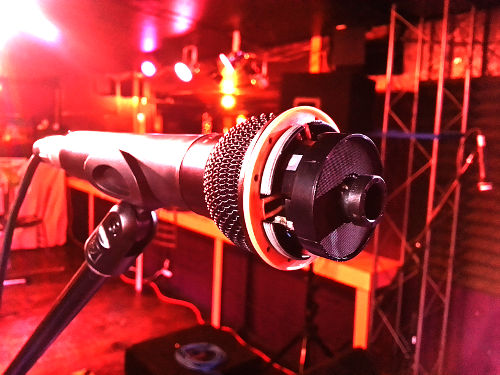A highly competent mic for a reasonable price.
Please Remember:
The opinions expressed are mine only. These opinions do not necessarily reflect anybody else’s opinions. I do not own, operate, manage, or represent any band, venue, or company that I talk about, unless explicitly noted.



This is what a 767a looks like with the “nose cone” removed.
Doug Wood (from the band Hostage and Woodshar Recording) tried to kill one of my 767a mics the other night.
Well, okay, he wasn’t doing it purposefully.
The mic stand had its boom almost fully extended, and the boom-angle was almost parallel to the floor. When you combine that situation with having the arm extended between two of the tripod legs (instead of along one of them), you’ve got a recipe for an unstable stand.
I think the whole shootin’ match went over about three times, with each occurrence sending a loud, dull “thop!” through the PA.
Hey, that’s what limiters are for. And reasonable powering.
I digress.
As he took action to very definitely secure the stand, Doug commented, “I haven’t dented your mic yet, but I’m working on it.”
So, yes, the N/D 767a can handle the inevitable accidents that occur on stage. That’s a point in its favor, but what else does the mic offer?
Sounds Good, Resists Feedback – If Used Properly
One of the first things I noticed about the N/D 767a is that it’s one of the few mics that sounds like the manufacturer got the “high end” right.
In my time, I’ve come across plenty of mics that sound dull, and I’ve come across plenty of mics that sound “overhyped.” The dull mics end up giving you that annoying, midrangey bark that just screams “old, worn out PA system from 1982.” The overhyped mics sound great when you’re standing alone on stage, sighting-in the monitor rig, but all that studio-quality top end stops being really useful when there’s an actual rock band in play. (There’s nothing inherently wrong with “air” in a vocal, but at high volume the air does little more than draw attention to itself.)
In contrast, the high-frequency component of an N/D 767a seems nicely smooth and natural, without any “FD&C Yellow #5,” as it were. This is important, because it allows the mic to have a clear and pleasing tonality without added feedback problems or “ess” sounds that cause windburn as they go by.
As a matter of course, I build an EQ preset for all my mics which is meant to “sound right in the solo bus.” Comparing presets is a sloppy metric – no argument there – but I can say that the N/D 767a is one of the least EQ’ed mics in my arsenal. To me, that says a lot about the mic being built well and voiced correctly.
These mics are designed to have a supercardioid pattern overall, and the overall implementation seems to resist feedback as well as other tight patterned mics I’ve encountered. Mounted on a stand with the correct orientation, or handheld by a competent vocalist, the 767 seems to be as trouble free as any other mic I’ve used. As with anything, you’ll need to do a requisite amount of “homework” when setting up. If you’re going to need to run at high gain, you’re also going to need to ring your monitor rig – no matter what mic you choose.
In a sense, one of the best compliments I can give these mics is that they just do what they’re supposed to do without a lot of fuss. With that being the case, there isn’t a whole lot of writing to do when it comes to the major positives of the 767a. You plug ’em in, you point ’em at something, they sound like that something, and off you go. In sound reinforcement, that’s what a mic is supposed to do.
Your Mileage May Vary
Currently, I’m convinced that there’s no such thing as the perfect mic for all situations. The N/D 767a works well across a range of applications, but there are some aspects of the unit that aren’t always ideal. It’s ironic that what amount to nitpicky concerns with the mic are what I have the most to talk about, but here we go anyway:
On the sound side, the mic’s pop-and-blast filtering seems to be just a little too “light” for a mic that people are going to be very – shall we say – personal with. The plosives and breath noise aren’t horrific by any means, but they still surprised me a bit at first. (To be fair, an appropriate-for-your-situation high-pass appears to help with this issue quite a bit, and now that I have some presets built for the mic, I don’t notice the problem much anymore.)
Tight patterned mics (supercardioid and “above”) are more finicky than their cardioid counterparts. As I said above, the feedback resistance on these units is what I would consider fit for varsity-level work. At the same time, though, that feedback resistance requires that the mic be in the correct orientation, and held the correct way. It’s my experience that tight pattern mics aren’t the right choice for people who want to combine high-gain monitoring with:
Turning every which way in a chaotic and unpredictable fashion.
And/ or working the mic at an inconsistent distance.
And/ or cupping the mic every now and then.
…and, of course, extreme practitioners of the above can’t be helped by any mic, so there’s that.
This restriction on application is by no means a failing of the 767a or any other similar mic, but it’s something to be aware of.
The physical construction of the units is nicely engineered, with everything fitting tightly. The XLR connector is what I would call “slightly recessed,” which necessitates a notch in the mic body so that the cable end can latch. This is hardly an issue in itself, but it becomes one when the internal assembly is rotated away from the notch. The XLRF on your cable will still mate with the mic’s pins, but the cable won’t latch. A good pull on the cable can result in the corresponding channel going silent – and in this case, the highly engineered construction becomes a hindrance. It would be a simple matter to rotate the internal assembly to match the notch if I could figure out how to do so without breaking the mic, but there’s only so much teardown that I’m confident in doing. N/D 767a mics just aren’t as user-serviceable as other stage transducers, and so they’re a little intimidating when you expose what internals you can.
Yeah, yeah, I should just Google for a teardown guide. I know.
Anyway.
My last nitpick is with the foam insert for the 767a’s grill. I can understand that there’s probably a good reason for it, but I also think that EV overcomplicated the whole thing. The actual insert is a small piece of foam that’s held in place by a tabbed, fabric ring. It doesn’t take very much to cause the ring to separate from the foam, and its easy to get the tabs bunched up. Getting the whole assembly back to factory stock is not a trivial thing. I’ve tried, and I can’t quite pull it off. This might not be a big issue for folks who rarely open their mic, but if you need to wash out your mic grills regularly, it’s a bit of a concern. The upside is that a “sorta fit” seems to work as well as an exact fit, but I just don’t see why over-engineering the pop-filter insert was so necessary.
Nitpicks Aside
The reason to go into detail about my little “dings” on these mics isn’t to discourage you from considering them. Rather, the point is to help you make an informed decision. I really like these mics, but I don’t want to give anybody the idea that they work miracles. No mic can do that, but you wouldn’t know it to read some of the reviews out there.
So…
I highly recommend the EV N/D 767a. They’ve earned a first-choice spot in my mic collection, and – in my opinion – they’re quite worth the small price premium over the industry standard. (You know, the thing with the model number of 58. I’m “Shure” you know what I mean.) To borrow the words of Yahtzee from Zero Punctuation, they aren’t perfect, but what is?
If you’re shopping for mics, put these on your short-list of contenders.